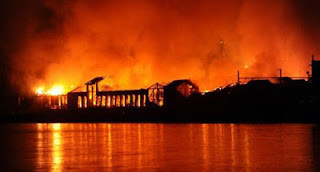Ko je bila leta 2007 Kvarkadabra med nominiranci za evropsko Descartesovo nagrado v kategoriji populariziranja znanosti, je v hudi konkurenci zmagal italijanski projekt Città della Scienza, ki je združeval interaktivni muzej, planetarij, konferenčni center, razstavni prostor za umetnike, inkubator novih tehnologij in še marsikaj drugega. Na leto ga je obiskalo 350.000 obiskovalcev in veljal je za mestno atrakcijo Neaplja.
Pred nekaj dnevi, v noči iz 4. na 5. marec, je kompleks Città della Scienza zgorel do tal. A ni šlo za nesrečo. Požar je bi, kot vse kaže, podtaknjen! (Slike požara: Naples ‘City of Science’ complex burns – PhotoBlog)
Just north of Naples, a smoldering ruin is all that remains of the museum called the City of Science. It was deliberately set it on fire during the night between March 4 and 5, and it is not hard to read the message behind its destruction.
The City of Science was created in 1996 as an ingenious way to reuse the gigantic Bagnoli steel plant, one of so many relics of Italy’s postwar plan to redeem itself through industry. Most of those industries have moved on, leaving unemployment, rotting structures, and environmental degradation in their wake. With a planetarium, exhibitions about classical physics, experiments about nature and daily life, and a program devoted to studying the future, the City of Science brought new ideas, new visitors, and new jobs to a blighted zone along one of the world’s most beautiful coastlines. By its very dedication to the future, the project declared its faith in a city too well known for its degraded present of crime and poverty. The museum was in perfect keeping with a once-glorious capital that is still glorious in many respects, with a new mayor, Luigi de Magistris, whose agenda has been to fight the city’s entrenched corruption and its chief corrupting agent, the local criminal organization known as the Camorra.
No doubt this campaign was part of what inspired the senseless attack on the museum. But the burning of the City of Science serves notice not just to Naples. Its message of brutality and despair is addressed to all of Italy. … According to one recent government estimate, corruption now accounts for $60 billion of the annual budget, while another study finds that more than 10 percent of the GDP is produced by organized crime. From North to South, well-placed organizations are happily doing business in their own way, by their own methods. The most dangerous prospect for Italy right now is not ending up like Greece; it’s ending up like Mexico. (Italy’s Future in Flames? by Ingrid D. Rowland | NYRblog | The New York Review of Books)









Povsem nerazumljivo. Imam tezave z "branjem sporocila" v ozadju tega dejanja.
To dejanje samo sporoča, kako močan je še vedno organiziran kriminal v Italiji (na Neapeljskem področju Camorra). Ne bi dosti zgrešil, če bi rekel, da je bil ta požig sporočilo, da ni dobro odtegniti kosa pogače "častitljivim ljudem". Priporočam prebiranje Savianovega romana "Gomorra", ki je doživel tudi slovenski prevod.